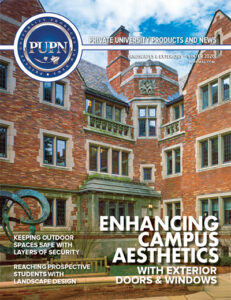Enhancing Campus Aesthetics — With Exterior Doors & Windows
—by Dr. David Vinson
There exists, of course, an obvious difference between a building and a painting. A building is designed foremost so that it can be occupied, and its design elements, whether they are intended to be beautiful or not, must abide by safety standards. But there is no rule that states a functional building cannot also be beautiful, and the study of aesthetics in architecture allows us to look holistically at the combined effects of a building’s shape, size, color, unity, proportion, symmetry, and context, among numerous other design elements.
Exterior windows and doors are a key component of any building’s aesthetics. Imagine a beautiful home, but one equipped with a shoddy door. A single design element on the “face” of the home can retract from the whole, thereby hindering its curb appeal. The same can be said of windows—a home (or any other building) can be transformed in look and feel by windows designed to let in more natural light. A window easily opened can create ventilation that cools a building, it can likewise reduce energy cost and usage or even thwart potentially contaminated airflow in busy indoor spaces—the latter of which is vital given the challenges we each face amidst the Covid-19 pandemic. Exterior doors and windows can also make a difference in keeping occupants safe from intruders.
With ongoing renovations and new projects at private universities and colleges around the country, institutions recognize the appeal of building exteriors to prospective and current students, in addition to the faculty and staff. For this reason, it would be remiss to overlook the extent to which exterior doors and windows can enhance the aesthetic value of building on campus.
Hope’s® Windows, Inc.— Two Campus-Based Case Studies
Formed in 1912, Hope’s® Windows, Inc. has since become a preeminent manufacturer of custom steel and bronze windows, doors, and skylights—sometimes referred to as window and door systems. Each item manufactured by Hope’s is 100% custom, and its doors, windows, and skylights can be tailored by designers and architects to align with just about any architectural style.
Hope’s customized window and door systems have graced the campuses of colleges and universities for over 100 years, beginning with its very first order for Prudence Risley Hall at Cornell University. Recently, Hope’s has embarked on several campus-based projects, one of which is the Chapel of the Resurrection at Valparaiso University (Valparaiso, IN). The chapel itself is one of the largest collegiate chapels in the world, the crown jewel of the 350-acre campus. Hope’s was hired to assist in the preservation project, and the company replaced nearly 1,000 individual windows. Installed were Hope’s Jamestown175™ Series steel windows, and these were selected to precisely match the sightlines and colors of the original windows. The 24 original windows surrounding the chapel’s nave were 58 feet in height and covered a combined surface of 16,700 square feet—and yet now they are both energy efficient and congruent with the historic integrity of the building. Moreover, each window was removed and replaced with fixed and operable Hope’s solid, hot-rolled steel windows. These are strong enough to allow for the narrowest frame dimensions and maximum glass area, thereby producing the best possible views.
At Stanford University (Stanford, CA), one can locate the Institute for Economic Research Policy, which stands as another example of stellar, campus-based work by Hope’s. The company’s engineering and manufacturing capabilities were put to the test by a project that included a 3-story wall system, fire-rated and non-rated doors and windows, custom shapes, custom-engineered sub-frames, reinforced muntins (a strip of wood or metal separating and holding panes of glass in a window), and more— all to accommodate for high slope, seismic drift, wind load, air, and water requirements. Hope’s met each challenge and successfully contributed to a structure that will stand the test of time.
The Remarkable Durability of Hope’s® Window and Door Systems
Whether by way of new construction, retrofit, or historic preservation, Hope’s has demonstrated a commitment to crafting windows and doors that are made to last for a century or longer, and the company has done so while simultaneously providing timeless aesthetic appeal. Hope’s solid steel and bronze windows and doors offer unmatched strength and performance, the thinnest sightlines of any fenestration material, monumental sizes, and design flexibility, plus energy efficiency and a long life cycle. The strength of Hope’s solid, hot-rolled steel can sustain incredible structural load requirements, which in turn enables the manufacturer to reach exact design requirements for monumental openings in virtually unlimited scale, shapes, and configurations. Hope’s manages all of this while also maintaining minimal sightlines and maximum glass area—a distinct aesthetic that cannot be duplicated by other materials.
Hope’s custom products are remarkably durable and wide-ranging in their utility, from hurricane and impact-rated windows and doors, to fire-rated window and door systems, and even to hot-rolled steel windows and doors with Thermal Evolution™ technology. Compare this life cycle to alternatives such as wood, vinyl, and aluminum, and it is evident that Hope’s represents the best long-term investment, whether financially or environmentally.
The products at Hope’s are also subjected to more independent, third-party testing and certifications than any other steel window and door company in the United States. As a reflection of the confidence that Hope’s has in its products, the company provides detailed testing results from industry organizations such as American Society for Testing and Materials (ASTM), the National Fenestration Rating Council (NFRC), the Florida Building Code, and many others. The testing addresses building code compliance, hurricane and impact resistance, forced entry security, thermal performance, fire resistance, bullet resistance, finish performance, blast protection, in addition to air, water and structural performance.
Regarding its finishing system, Hope’s has developed in cooperation with top U.S. metallurgists and architectural costing suppliers the Hope’s Power of 5™ Finishing System. The system has been engineered to ensure that windows and doors remain pristine and free from both corrosion and abrasion on a long-term basis, even in the harshest environments, whether inland or coastal. Hope’s steel window and door coatings are lead-free, contain zero hazardous air pollutants (HAPs) and have ultra-low volatile organic compounds (VOCs).
Hope’s Commitment to the Environment and to the Consumer’s Well-Being
For universities and colleges that have embraced the culture of sustainability, be sure to note that Hope’s creates energy-efficient windows and doors from sustainable materials. The steel windows and doors are made with hot-rolled steel sections that are 100% recycled (97% post-consumer, 3% post-industrial). Because Hope’s cares about sustainability and energy efficiency, the company is glad to assist building owners and architects in fulfilling credits within the LEED® Rating System.
Windows manufactured by Hope’s allow for larger openings and narrower frames, which allow more natural daylight to fill a room. Natural light not only reduces energy consumption, but it promotes a feeling of well-being and can positively impact the mood and productivity of building occupants. This would be especially beneficial in campus spaces such as classrooms, libraries, or dormitories.
Cleaner, Healthier, and More Versatile Learning Spaces
Hope’s understands that the Covid-19 pandemic weighs heavily on the minds of students, faculty, and staff. As such, it offers a variety of window and door operating types, those such as projected and casement, top hung, single hung, and pivoted windows as well as swing, pivot, and siding doors for ventilation. In a 30-foot classroom occupied by 25 students, the air should be replaced at least every 15 minutes, which equals an Air Changes per Hour (ACH) of 4. Simply opening windows is an easy way to improve ventilation. Researchers at Harvard University have found that opening the windows in a room just six inches can result in an ACH of 5 or more with clean, outdoor air.
In addition to its exterior windows and doors, Hope’s offers custom designs of doors and walls of windows for interiors. These define and separate spaces without blocking natural light, thereby creating airy and inviting indoor spaces. Hope’s interior windows and doors have been installed to define public interior spaces (research labs, fitness facilities, and more) at institutions like MIT’s School of Architecture and Planning.
The “Face” of Campus-Based Buildings
Our campus buildings should be a source of pride, not simply for their functionality or versatility, but also for their aesthetic value. The “face” of campus-based buildings matter to prospective students, just as they do to current students, faculty, and staff.
Exterior windows and doors are a key component of any building’s outward appearance, but when also designed properly—as we have seen with Hope’s windows and door systems—they can also transform a building’s interior into spaces that are cleaner, healthier, and more energy efficient.

This article was the cover story in the Winter 2020 issue of Private University Products and News.




